48hr Gulf Crossing
Hey guys! This was a tough post for me to write, and I suppose I have been putting it off. Writing this post meant reliving the journey, which was stressful to say the least. Sorry it took so long, hope to get back in the groove now that the holidays have passed! Be sure to check out the video section as there are some new ones up (from pensacola and from panama city). Big thanks to Ray who we met in Chattanooga on Chikamuaga for giving me the motivation to finish this up! I hope you enjoy, and drop any questions or comments below. I love hearing from everyone!
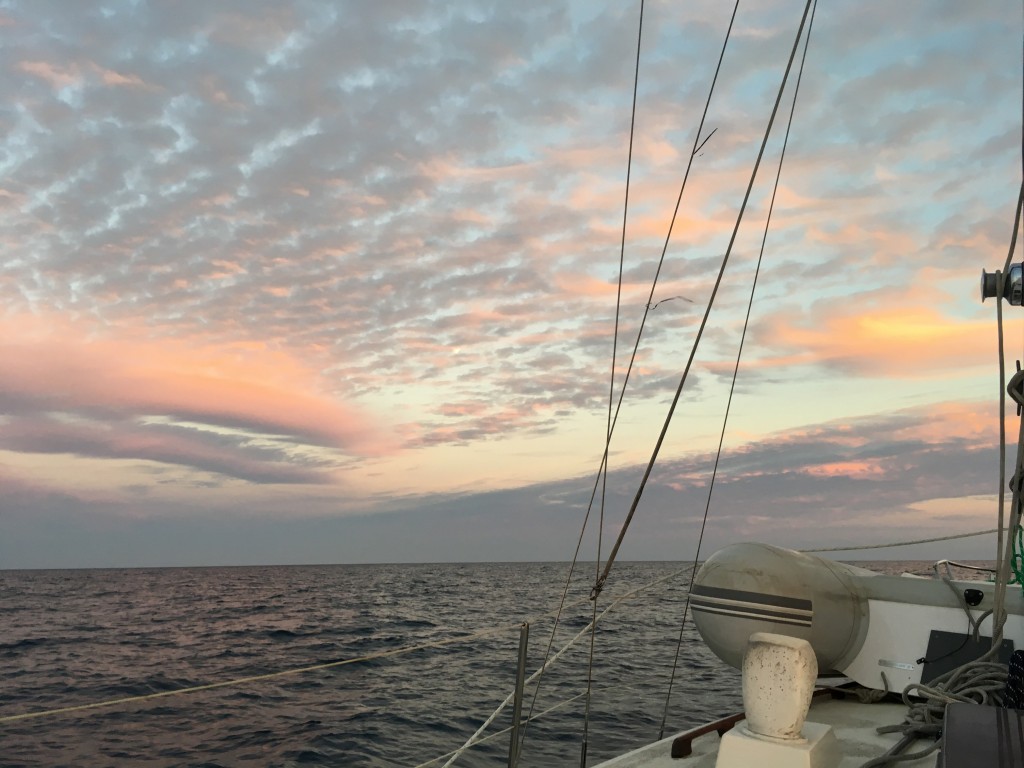
We stayed a couple weeks here and couple weeks there while we were in Panama City, and before we knew it a whole month had passed! It was starting to cool down and I was ready to get a move on somewhere! We discussed potentially heading further east to Appalachicola, but anchorages looked scarce. If we did make it that far east we could potentially be waiting weeks for the ideal weather window and without many good looking anchorages we sort of just put it off. Any further east than Appalachicola and you are in the “armpit of florida” where its too shallow to head to shore, there are no protected anchorages, and there is no intercoastal waterway. So you could hug the shore and head south, but it would take three times longer and there are no benefits. So when the perfect weather window opened up for us, we decided to go ahead and make the jump from Panama City to St. Pete (area).
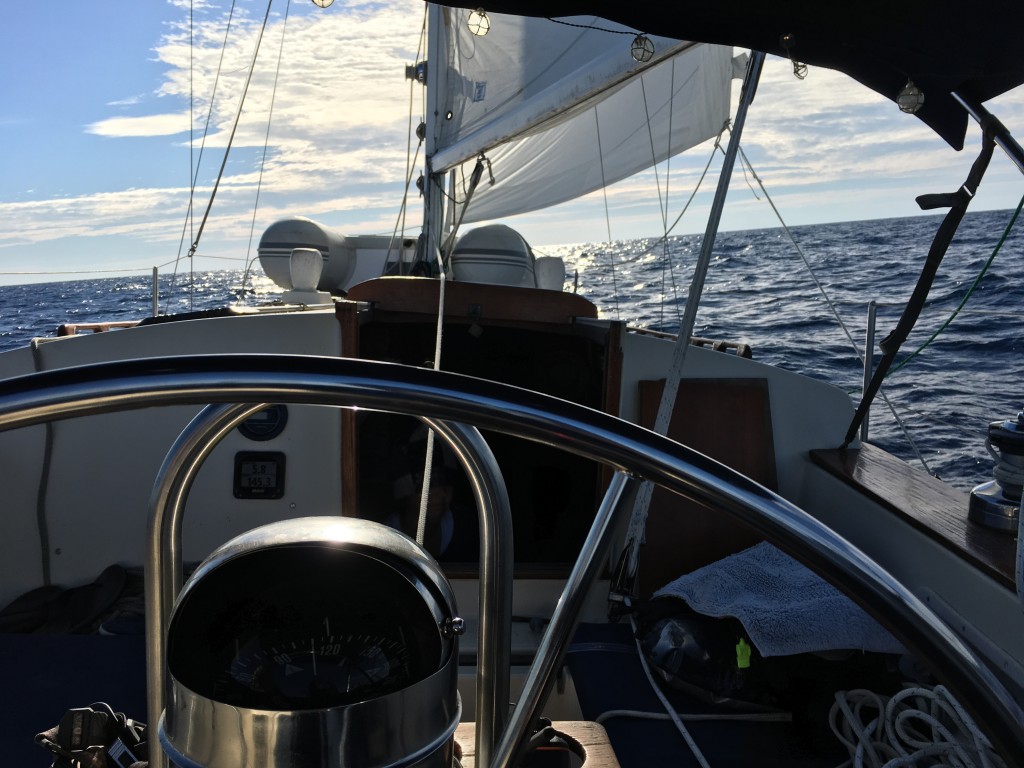
It is about a 200 mile journey from Panama City to St. Pete, and we talked with our folks about what we were doing, and that it should take us between 48-72hrs depending on wind conditions. We left my dad in charge of contacting authorities if we were past due by a day or two. We knew after a couple miles offshore we would lose all cell phone service. We pumped out, filled up on water, and still had plenty of diesel from our last attempt out of Pensacola. Our fuel tank holds 20 gallons, and we carry an extra 20 gallons in jerry cans, so it was comforting knowing that if worse came to worse we would have enough fuel to run the motor the entire time.
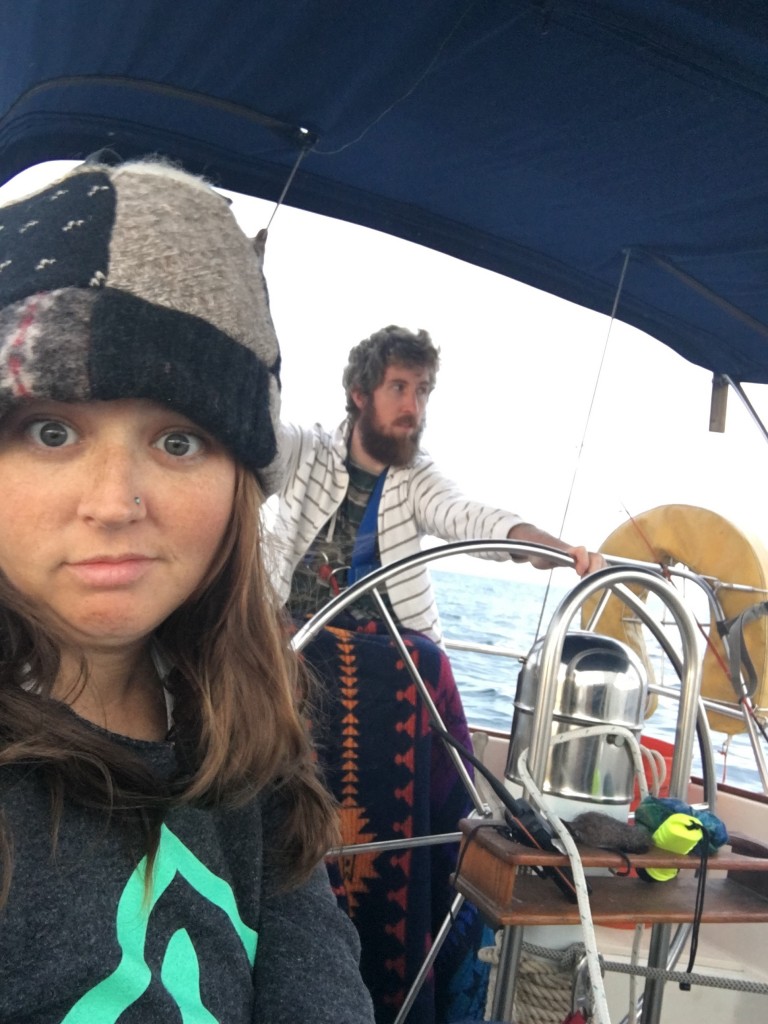 The wind was non existent when we left Panama City at around 10am. We motored for about the first 6-8hrs. I was proactive about my seasickness and put a patch on an hour before we left (Though it did suggest doing it 12hrs before, I didnt read that till it was too late). The seas were super calm and so we went, a good start to an arduous trip.
The wind was non existent when we left Panama City at around 10am. We motored for about the first 6-8hrs. I was proactive about my seasickness and put a patch on an hour before we left (Though it did suggest doing it 12hrs before, I didnt read that till it was too late). The seas were super calm and so we went, a good start to an arduous trip.
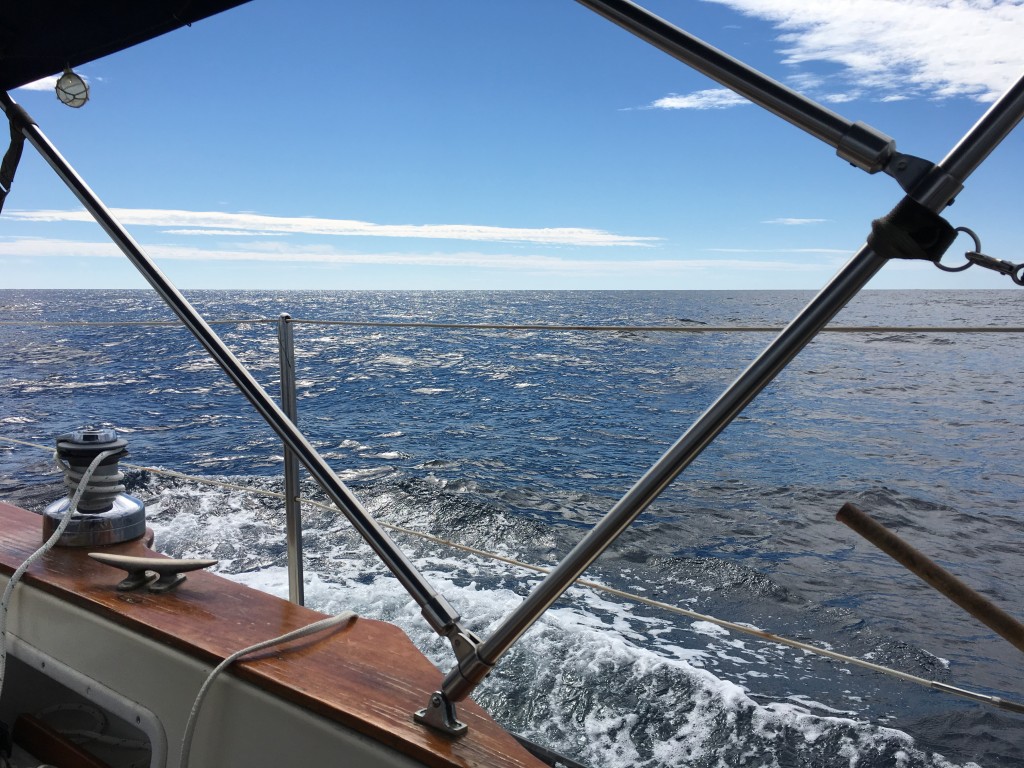 It was still nice and calm around noon so I went down below and made some sandwiches. This was similiar to all the trips we had taken thus far. We had just lost sight of land. Knowing we were in for the long haul Erik went and laid down for a spell while I drove on. By the time he got up the wind had picked up a bit and we adjusted the sails to take full advantage. Leaving Panama City we headed due South for about 8 hours or 50miles before we began heading East South East. We manually held our course using the compass and steering wheel since we have no autopilot. Usually this hasnt been an issue for us as we have been taking short day trips using landmarks to help navigate, but when you are out there in the middle of the ocean there are no landmarks. If you quit paying attention it was very easy to go off course. At some point we switched out again so Erik could drive through the dusk.
It was still nice and calm around noon so I went down below and made some sandwiches. This was similiar to all the trips we had taken thus far. We had just lost sight of land. Knowing we were in for the long haul Erik went and laid down for a spell while I drove on. By the time he got up the wind had picked up a bit and we adjusted the sails to take full advantage. Leaving Panama City we headed due South for about 8 hours or 50miles before we began heading East South East. We manually held our course using the compass and steering wheel since we have no autopilot. Usually this hasnt been an issue for us as we have been taking short day trips using landmarks to help navigate, but when you are out there in the middle of the ocean there are no landmarks. If you quit paying attention it was very easy to go off course. At some point we switched out again so Erik could drive through the dusk.
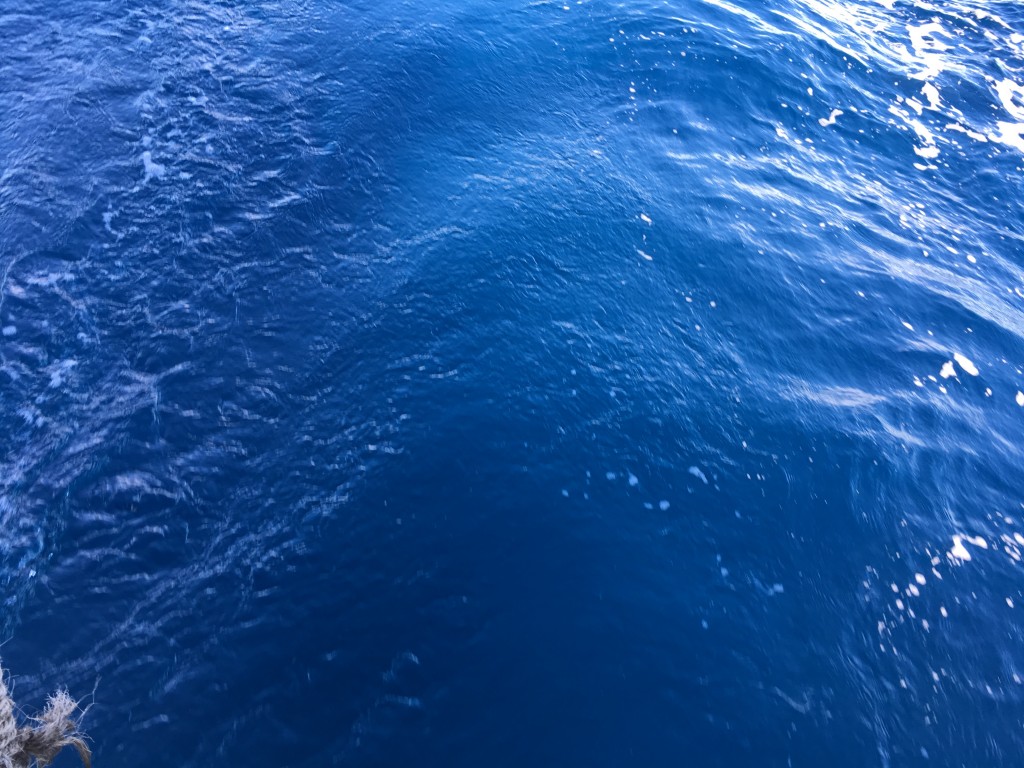
a beautiful deep blue in the middle of the gulf
We have read about autopilot and it sounds lovely, but it is not cheap. After this passage we have decided autopilot is a necessity! We are in the market for one as we speak! (Edit: We have one now! See review HERE) You simply program it to the direction you wish to head and it holds the course. Of course someone must still be on watch, but instead of gripping the giant wheel and wearing out your shoulders literally the entire time, you could simply check that its on the right course, check your surroundings, make some food, read a book, adjust sails, stretch, and pretty much any other activity that is essential for traveling. Without the autopilot we really wore ourselves out.
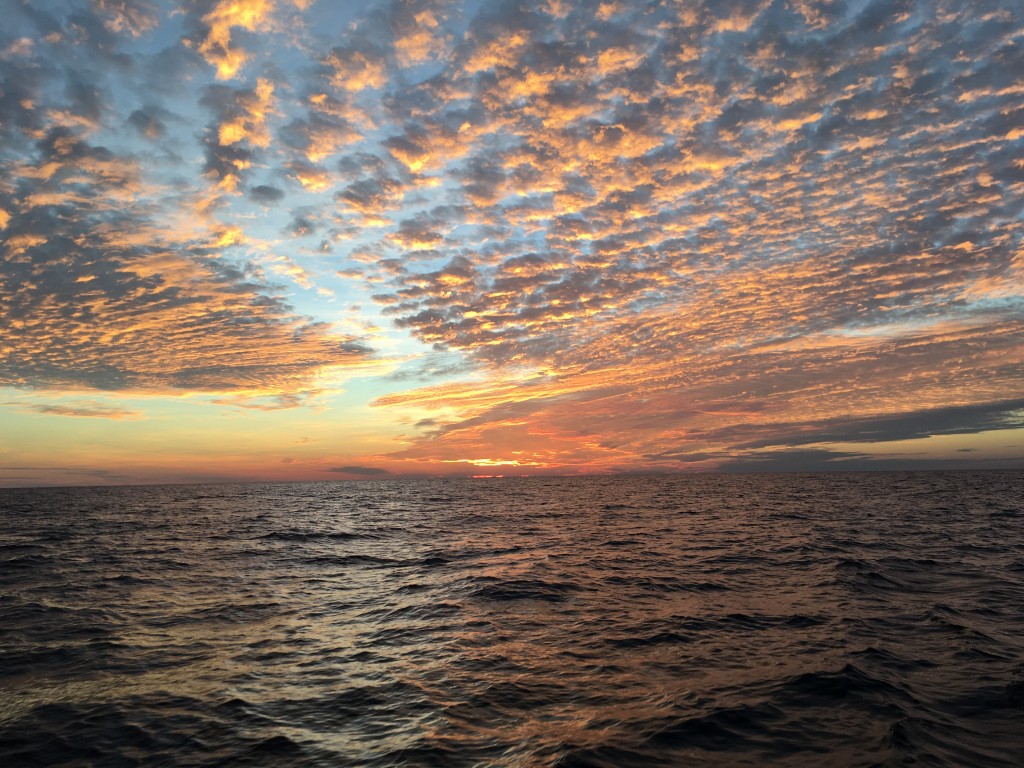
mazing sunset at the beginning of night 2
After the sun set on the first day, it began to set in that we still had quite a long way to go. I took over the first night watch, as I can stay up sorta late but Erik is a true night owl. I was up from 9pm-1am. And I was really struggling. My mind went to scary places, but I tried not to go too deep. Things like what if the engine dies, well then we have sails. What if the sails break, well then we have an engine (and back up sails). What if all of our through hulls failed simultaneously and our boat sunk instantly…. well that won’t ever happen but we do have an EPIRB. I was nodding in and out from exhaustion when I thought I was hallucinating. I was seeing things, dolphins, but they were real! A giant pod of 20 dolphins swam beside me in the middle of the night. I was so excited it gave me the energy needed to push on until Erik came up.
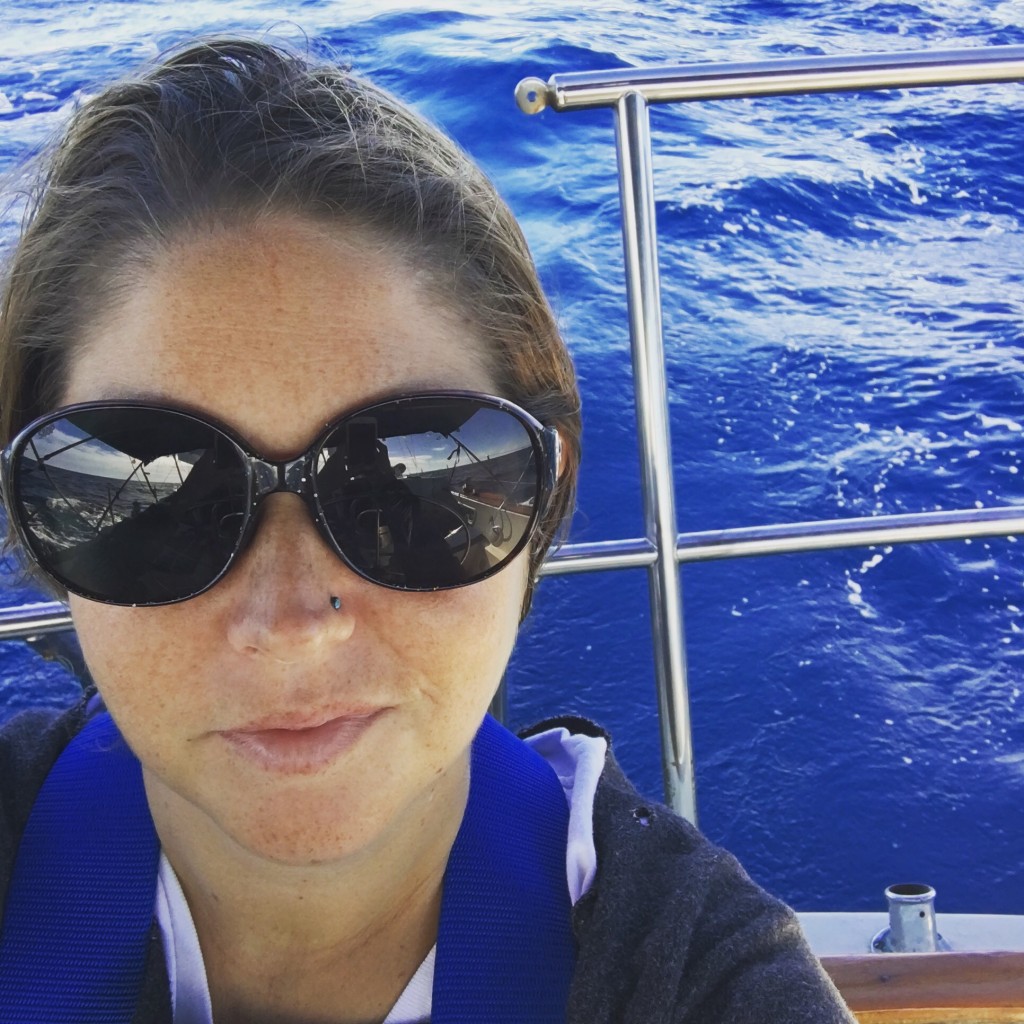 He finally relieved me and I went down below for some rest. Sleeping while traversing an ocean is not good sleep. You get into a rythmic motion of the waves slapping the hull, the boat rocking back and forth, and eventually your eyes close. But as soon as the motion is disrupted I would wake up until I was lulled back to sleep. My neausea was mild, but laying down really helped. At around 6am I rose to a beautiful sunrise with everything good and under control. Erik and I switched off. We were making really good progress sailing at about 6 knots through the entire night.
He finally relieved me and I went down below for some rest. Sleeping while traversing an ocean is not good sleep. You get into a rythmic motion of the waves slapping the hull, the boat rocking back and forth, and eventually your eyes close. But as soon as the motion is disrupted I would wake up until I was lulled back to sleep. My neausea was mild, but laying down really helped. At around 6am I rose to a beautiful sunrise with everything good and under control. Erik and I switched off. We were making really good progress sailing at about 6 knots through the entire night.
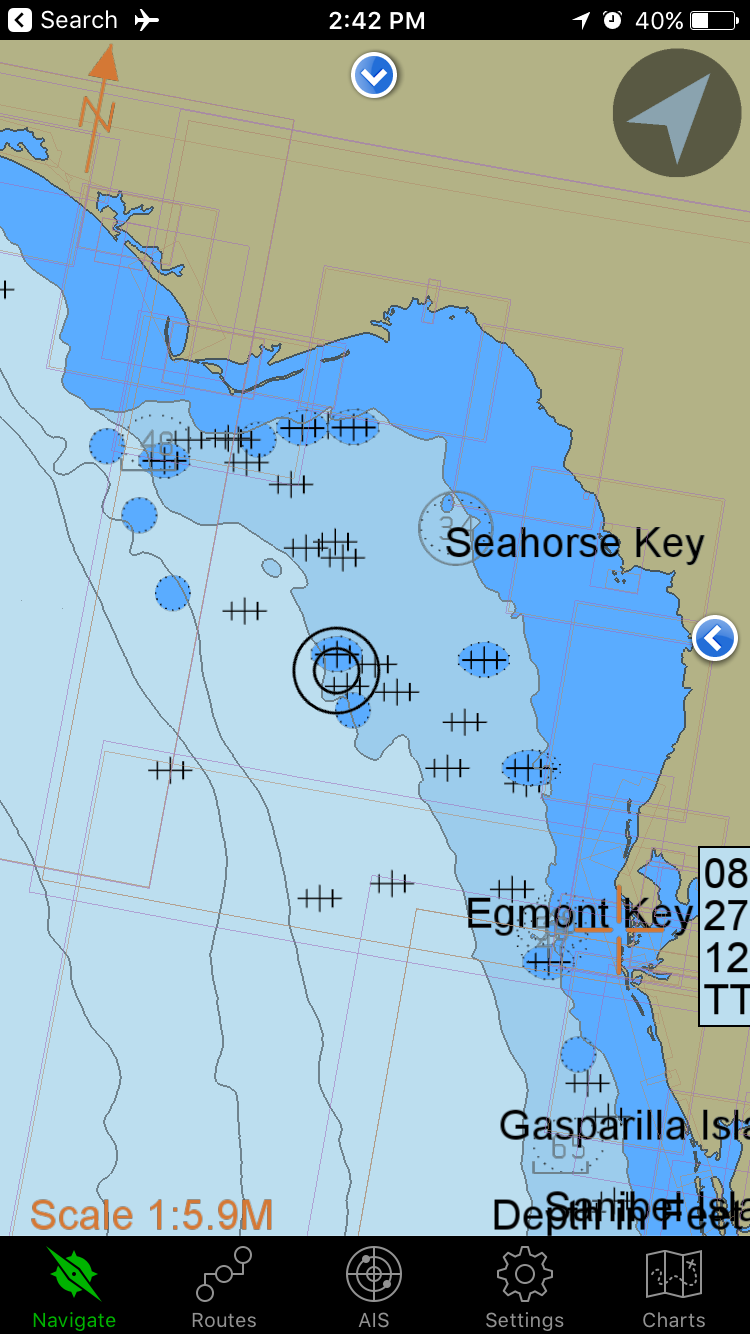
this is a screen shot from my phone, at about the half way point. We are the two circles and were 100 miles from land
The next morning at the 24 hr mark, around 10am, we were headed into the wind. So we kept the main sail up and turned the motor on so we could continue making good progress. Having the sail up really helps with the rocking of the boat. I napped in the afternoon while Erik drove, and then switched off in the later afternoon. Around 3pm the wind was extremely light so we continued motoring. As the sun began to set on the second day the wind picked up. Erik adjusted the sails for me as I was on watch and he napped. As the sun set we had about 70 miles to Tampa. While it was my turn everything was going smoothly and the sailing conditions were great! We were going at least 6knots and the seas were minimal. But the wind and seas really started to pick up late into the night. Once we began to feel overpowered by the wind with both sails up, we attempted to roll up the foresail. It was mostly rolled but the last little bit wasn’t wanting to roll up, so Erik gave it all he had and winched in the furler line when it snapped! It was very high wind so if he didn’t act fast we could’ve been in some trouble. Luckily he’s quick on his feet and ran to the front of the boat to cleat off the line and wrap up the foresail very tight for the last leg of the trip. That was a little nerve wracking! Then even with the main sail up we still felt too overpowered, so he also took that sail down. It was very stressful for me as I was handling the boat in large seas and we were bobbing around I just imagined him falling off in the dark (Erik points out that he was tethered by a harness…) and by the time he got back to the cockpit I was in tears from the stress and exhaustion. In retrospect, this is where we should have reefed the mainsail instead of taking it down fully, because with no sail up to stabilize the boat, the waves were really knocking us around violently. At this point we only had 20 more miles to go, so I went and laid down until the sun started to rise.
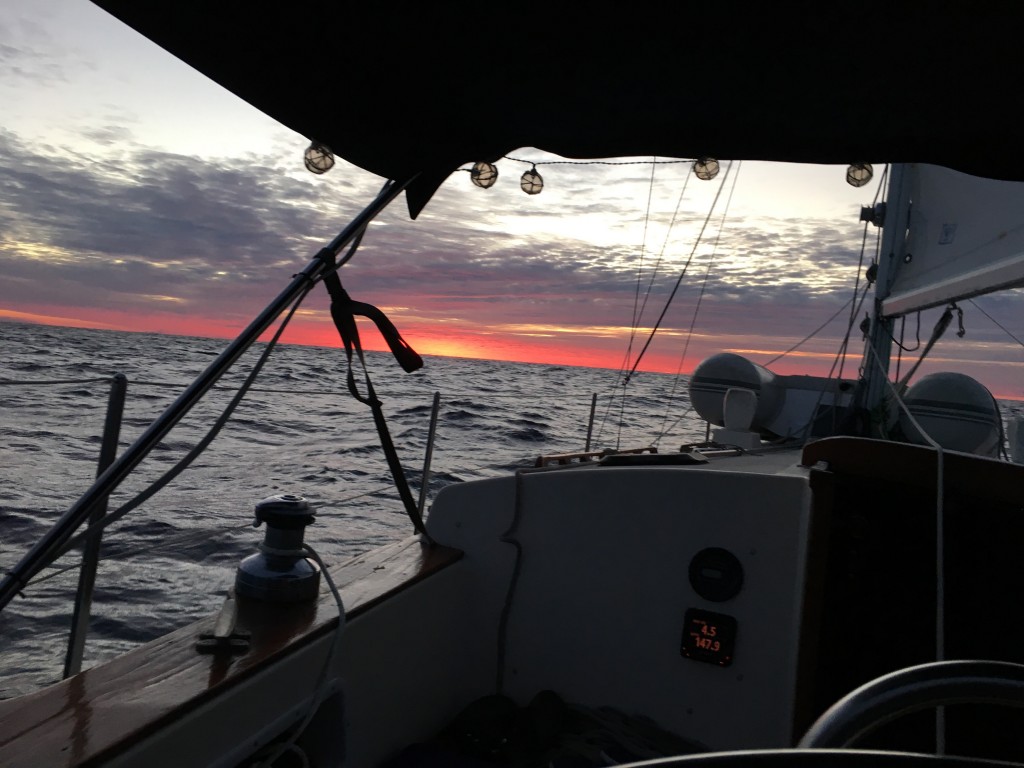
sunrise
When I got up around 5am, we were so close yet so far. The sunrise was beautiful, and though I could not see land I could see the red lights of a cell tower blinking in the distance. I knew we were close! After the long and stressful night Erik finally went to lay down. After about 30min I hear a loud “THUNK DA THUNK DA THUNK DA THUNK DA THUNK” and in my delusional state of exhaustion I had no idea what was happening when Erik hollered from down below, “The anchor! Put it in neutral!”. The anchor had somehow worked itself loose and self deployed! Only about 10 miles offshore we were in 80ft of water… we have 75ft of chain, 225ft of rope so a total of 300ft and when Erik got the the front there was only about 15ft left in the anchor locker. We were so close to losing our brand new anchor set up! Erik said there is a large knot tied in the end that would probably stop us from losing it in calm conditions, but honestly it probably would’ve ripped the anchor locker door right off if it caught with enough force! We were lucky ducks. Erik took a lot into consideration when we invested in our new anchor system. The fact we have no windlass and how much our entire rode would weigh when completely deployed was a factor he considered, and he sized it to be still barely manageable to pull in by hand even when all the chain is hanging free in deep water. So he puts on some gloves and goes and sits at the front and slowly pulls up the rope, while I’m in the cockpit trying my best to drive the boat toward the anchor to help pull it in. The seas were rough and sloshing around. Finally Erik managed to get it all pulled up (and secured) and laid back down.
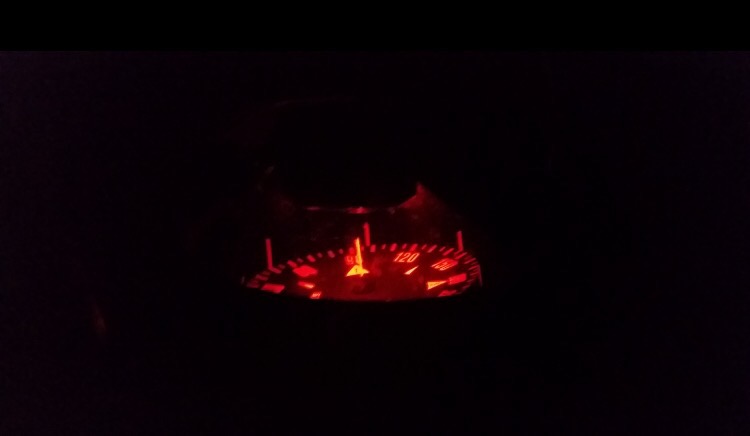
Imagine staring into the red compass at night as it wobbles around for hours on end, making course corrections every 5 seconds when a wave hits the boat.
Early in the morning I could see buildings but as the day progressed a fog set in, so I lost sight of land even though we were so close it still seemed so far! I was definitely delusional, and the boat traffic was confusing me as to where the inlet was, but I just followed the gps the best I could. There were tons of boats out, it was early Sunday morning. And then there were crab pots, rows and rows and rows of crab pots. They are very small floating bouys that you can’t see when the sun, wind, or waves hits them just right. And with the dinghy strapped on the bow of the boat it made it even more difficult to spot. I dodged them for at least 2 hours before Erik woke up and helped me out. And then we were there! The channel was right in front of us! We wearily navigated behind other boats (it was packed!) on the ICW and found a decent, good enough spot, for some rest at around 10am. We joked about how the minor wake we got from passing boats was peaceful compared to the large seas we just sailed. And then we slept.
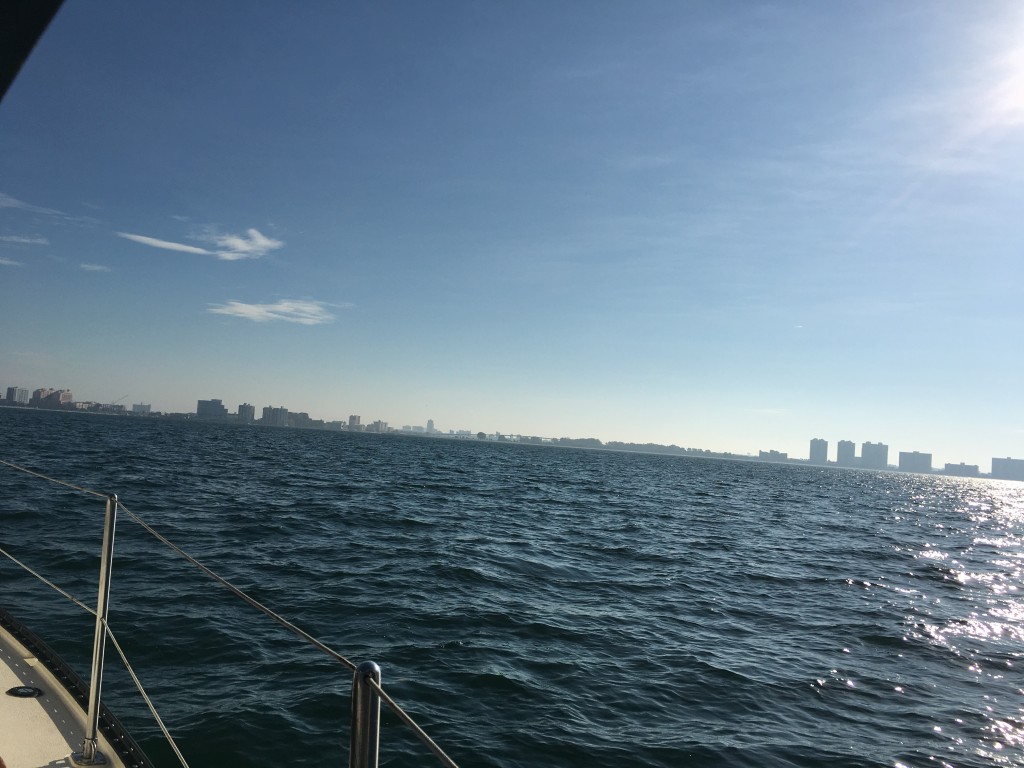
hazy clearwater
We got up in the evening, and ate a little bit of food, the first in a very long time. I only threw up once on the entire trip, but my stomach was in knots and I never felt hungry. We probably only ate 3 meals on the entire 48hrs. Anyways after we sat around for a little bit in awe of what just happened, we went back to bed. Overall the trip was a huge success! Our engine never gave us any grief, we didn’t sink the boat, and we made it in one piece. I think we also learned a lot from the trip as well, so thats always good! However it was a lot more difficult than either one of us imagined, it was a true test of endurance. We will take all the lessons learned and mistakes made and hopefully make our next journey better!

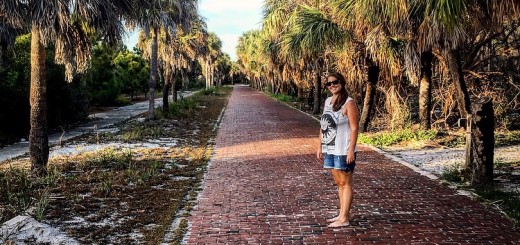
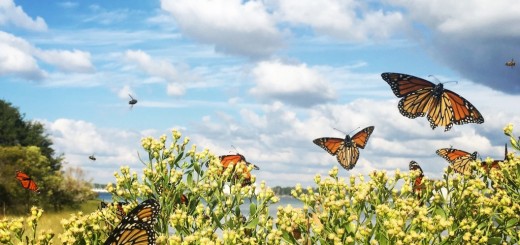
Thanks for such a candid account-I’m about a year behind you, so am enjoying all of your stories! Not knowing what to expect is usually half of the anxiety, so now you’ve done a nice long overnight passage the next ones will seem much easier! Keep on sailin’!
Glad you’re enjoying it! I think we were so worn out because we had to be holding course the entire time. And that 200 mile passage is the longest one we have planned for the next year or two, as it is only 90 miles to the Bahamas and we plan to island hop all over the Caribbean. Wish we bought autopilot sooner, had no idea how important it would be.
I felt your anxiety deeply, I hope your travels are smooth from here on out. Tremendous story and you are an amazing writer. I see books in your future.
Thank you so much, glad its finally out there! Miss you and your sweet family! I may or may not have colored for days to try to get over my ptsd 🙂
Oh, baby! I knew this would be difficult to write, and was much more difficult to live through! Thankful for Erik’s excellent skills! You’re a perfect first mate for him! Love you both! Thanks for these blog posts and videos!
Oh my goodness! I was on the edge of my seat reading this one! Glad it ended well. PS, enjoyed your last video – doing great on camera, girl!
Wow CJ! Talk about endurance and guts- you’ve got both, way to push through and think on your feet. I can feel the relief of landfall from here! Happy sails on the continued journey!
Enjoyed the write up!
I love your story, ive been there and done that ,ive sailed all over the eastern seaboard. I love sailing in the open ocean
It’s quite a feeling knowing you are the only one around for hundreds of miles around… When it was smooth it was great, and the challenges taught us a lot.
Well done on the trip. That’s a long way to go for a first time voyage (and without an electronic helmsman). Congrats on the landfall. Things should be much more manageable now. Best of luck.
Bill, Alohalani, A34, Oakville Ont.
Great to see an update. Sounds like you guys are learning every day.
Hey CJ and Erik I enjoyed the new post and video. Very good writing and photos. What an adventure even though it was grueling it’s good to know you can sail manually in case the auto pilot breaks down. Enjoy the auto pilot! Way to face and conquer fears we all have. Love you and very proud, DAD
On our Aloha 34 (“Bella”) we have a safety pin (a quarter inch thick stainless pin that has an end button to control a spring-loaded inner slide; when pressed from the end the inner slide allows two balls on the far end to slide inward so the pin can be pulled out) that passes through port and starboard holes drilled in the upper edges of the bow anchor guide. When it is in place the anchor cannot bounce upwards so the anchor cannot slide forward and “auto set”. Maybe there is a place to add such a device with your anchor mount and new anchor.
Thanks so much for your blogs following the purchase and repair of your Aloha 34. We have a Pacific 30 that we have been living on for almost 5 years now here in Victoria,B.C. Canada. I can relate to the work you have done having done similar work on ours ( a Ray Richards design from 1971).
We have narrowed our next boat also to an Aloha 34 and I appreciate what to look for although not completely sure about taking one offshore which will affect our choice. Good Luck with your sailing adventures. John and Rebecca
Glad you found us! There’s not a ton of info out there on Alohas (because there aren’t that many i suppose) But through our research it seems that there is at least one over in New Zealand, so one has made it across the Pacific. Did you make your choice on if you are getting it!? I really love our boat for two people, and we definitely plan on doing the carribean but going farther/further is still debatable. I have great confidence in her now after the work we have put into her.
CJ / Erik,
With the announcement recently from Sundowner I thought I’d leave a comment with best wishes for you. I hope everything is going well.
Wow! I know that completely shocked me too, they are one of my favorite blogs to follow! I have a feeling they will make it back to the ocean eventually, and understand that its better to sell now than let the old girl sit. Nothing is worse for a boat than non-use. We are doing very good, but I suppose I’ve had writers block or lack of motivation. We just anchored at sanibel for the night, and there is wifi here, so perhaps I will try to knock out another update (or two!). Thanks for following us, our tentative plans include heading south to the keys, a trip to the tortugas, up to ft. lauderdale, then east to the bahamas! We move about the pace of a snail though so no timeline, just when the weather works.
Your courage is inspiring and awesome. Definitely may need to recruit people willing to fly in & out to do your larger crossings. It helps to have a few more hands on deck. Great job though! Wonderful!